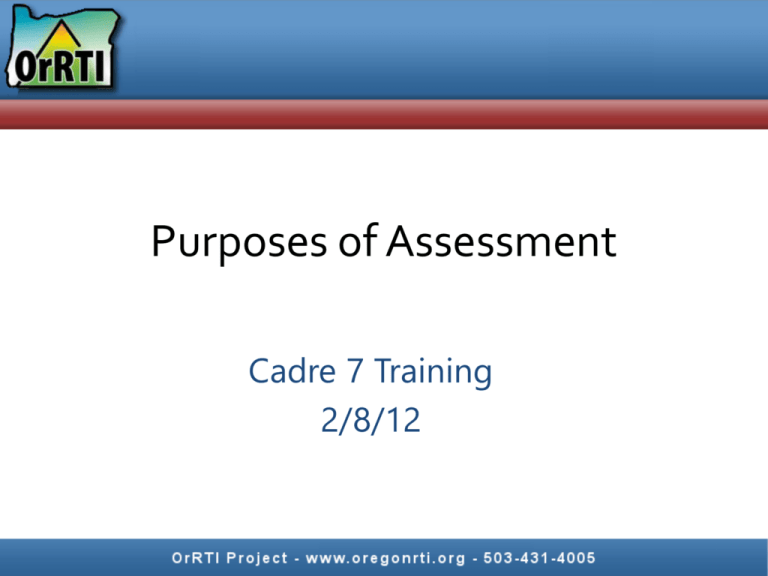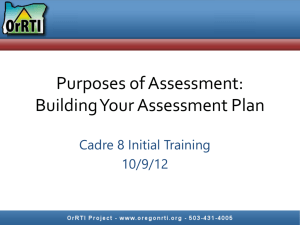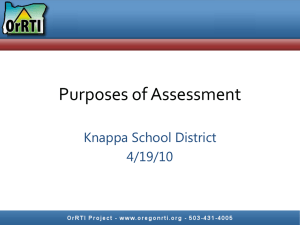Progress Monitoring
advertisement

Purposes of Assessment Cadre 7 Training 2/8/12 Objectives • Team members will have a clear understanding of the four purposes of assessment • Team members will develop a District Assessment Plan by the end of day 2 What assessments are you currently using in your district? • Take 5 minutes and in your district teams brainstorm a list of all the different assessments your district is currently using • Save the list-we will be revisiting it periodically throughout the presentation Purposes of Assessment 1. Screening 2. Progress Monitoring 3. Diagnostic 4. Outcome Assessment Plan Purpose Screening Progress Monitoring Diagnostic Outcome Assessment Big Idea(s) Tested Who is Tested Frequency Who Administers /Types of Reporting Screening Why give Universal Screeners? – To determine the health of the core • Make instructional changes to improve core instruction – To identify students who need additional instructional support – Are staff using the screening data for BOTH these reasons? Universal Screening • Who: ALL students – Do all staff believe that it should be for ALL? • When: 3 times a year – Fall Winter Spring What makes a universal screener “good”? • Robust indicator of academic health • Brief and easy to administer • Can be administered frequently • Must have multiple, equivalent forms – (If the metric isn’t the same, the data are meaningless) • Must be sensitive to growth A universal screener should over-identify students who might need something more! What are some commonly used screening tools? Reading AIMSWEB Reading CBM, Maze DIBELS NEXT FSF, PSF, NWF, ORF, Daze easyCBM PSF, LSF, WRF, PRF, MC Reading Comp, Vocab Math AIMSWEB M – Computation, M – Concepts & Applications, CBM – Early Numeracy easyCBM Numbers & Operations, Measurement, Geometry, Algebra Written Language Writing – CBM (Total Words Written, Correct Writing Sequences, Words Spelled Correctly) What are NOT good screening tools? Reading •Quick Phonics Assessment •Report Cards •OAKS •DRA •Running Records •QRI •Fountas & Pinnell •Reading curriculum weekly or monthly tests or fluency passages Math Curriculum weekly tests Teacher created math probes* OAKS Written Language Writing rubrics* OAKS * when not administered and scored in a standardized and reliable way, or checked for consistency of multiple probes Screening Purpose Screening Progress Monitoring Diagnostic Outcome Assessment Big Idea(s) Tested Who is Tested Frequency Who Administers /Types of Reporting Progress Monitoring as an “Indicator” Progress Monitoring Tools Brief & Easy Frequent Sensitive to growth Equivalent forms!!! Progress Monitoring Tools Curriculum-Based Measures (CBM) General Outcome Measures (GOMs) What are some commonly used progress monitoring tools? Reading AIMSWEB Reading CBM, Maze DIBELS NEXT FSF, PSF, NWF, ORF, Daze easyCBM PSF, LSF, WRF, PRF, MC Reading Comp, Vocab Math AIMSWEB M – Computation, M – Concepts & Applications, CBM – Early Numeracy easyCBM Numbers & Operations, Measurement, Geometry, Algebra Written Language Writing – CBM (Total Words Written, Correct Writing Sequences, Words Spelled Correctly) What are NOT good progress monitoring tools? Reading •Phonic Screeners •Report Cards •OAKS •DRA •Running Records •Reading curriculum weekly or monthly tests or fluency passages Math Curriculum weekly tests OAKS Teacher created math probes* Written Language Writing rubrics* OAKS * when not administered and scored in a standardized and reliable way, or checked for consistency of multiple probes Using the Right Tool The progress monitoring tool should match the skills being taught. Additional Progress Monitoring Tools For more info and a review of available tools, visit www.rti4success.org (Progress Monitoring Tools Chart) What information does it give you? Reading Curriculum Fluency Passages/Weekly Tests VS. Progress Monitoring Tools (CBM) What information does it give you? Reading Curriculum Fluency Passages/Weekly Tests VS. Progress Monitoring Tools (CBM) What information does it give you? Reading Curriculum Fluency Passages/Weekly Tests VS. Progress Monitoring Tools (CBM) Progress Monitoring Purpose Screening Progress Monitoring Diagnostic Outcome Assessment Big Idea(s) Tested Who is Tested Frequency Who Administers /Types of Reporting Diagnostic Answer the question… Why? Diagnostic assessments may include: • • • • Quick Phonics Screener Survey Level Assessments Error Analysis or Running Records Any formal or informal assessment that answers the question: – Why is the student having a problem? Diagnostic Assessment Questions “Why is the student not performing at the expected level?” “What is the student’s instructional need?” We do not use diagnostic data… …for all students …to monitor progress towards a long-term goal …to compare students to each other Diagnostic Purpose Screening Progress Monitoring Diagnostic Outcome Assessment Big Idea(s) Tested Who is Tested Frequency Who Administers /Types of Reporting Why use outcome measures? • To determine how well students are doing at the end of an instructional time period (lesson, unit, year) Why use outcome measures? • To determine if a goal was met Examples of Outcome Measures • • • • • • OAKS End of Unit/Program Assessments Stanford Achievement Test DIBELS EasyCBM Aimsweb Outcome Purpose Screening Progress Monitoring Diagnostic Outcome Assessment Big Idea(s) Tested Who is Tested Frequency Who Administers /Types of Reporting Final Questions/Comments Tara Black tblack@ttsd.k12.or.us (503) 431-4148 Jon Potter jpotter@ttsd.k12.or.us (503) 431-4149




